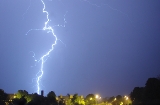
Electrostatic discharge
Overview
Electronics
Electronics is the branch of science, engineering and technology that deals with electrical circuits involving active electrical components such as vacuum tubes, transistors, diodes and integrated circuits, and associated passive interconnection technologies...
, such as integrated circuit
Integrated circuit
An integrated circuit or monolithic integrated circuit is an electronic circuit manufactured by the patterned diffusion of trace elements into the surface of a thin substrate of semiconductor material...
s. Integrated circuits are made from semiconductor
Semiconductor
A semiconductor is a material with electrical conductivity due to electron flow intermediate in magnitude between that of a conductor and an insulator. This means a conductivity roughly in the range of 103 to 10−8 siemens per centimeter...
materials such as silicon
Silicon
Silicon is a chemical element with the symbol Si and atomic number 14. A tetravalent metalloid, it is less reactive than its chemical analog carbon, the nonmetal directly above it in the periodic table, but more reactive than germanium, the metalloid directly below it in the table...
and insulating materials such as silicon dioxide
Silicon dioxide
The chemical compound silicon dioxide, also known as silica , is an oxide of silicon with the chemical formula '. It has been known for its hardness since antiquity...
. Either of these materials can suffer permanent damage when subjected to high voltages; as a result, there are now a number of antistatic device
Antistatic device
An antistatic device is any item which has the effect of reducing static electricity charges on a person's body or equipment, either to prevent fires and explosions when working with flammable liquids and gases, or to prevent damage to static-sensitive objects such as electronic components or devices...
s that help prevent static build up.
One of the causes of ESD events is static electricity
Static electricity
Static electricity refers to the build-up of electric charge on the surface of objects. The static charges remain on an object until they either bleed off to ground or are quickly neutralized by a discharge. Static electricity can be contrasted with current electricity, which can be delivered...
. Static electricity is often generated through tribocharging, the separation of electric charges that occurs when two materials are brought into contact and then separated.
Unanswered Questions

